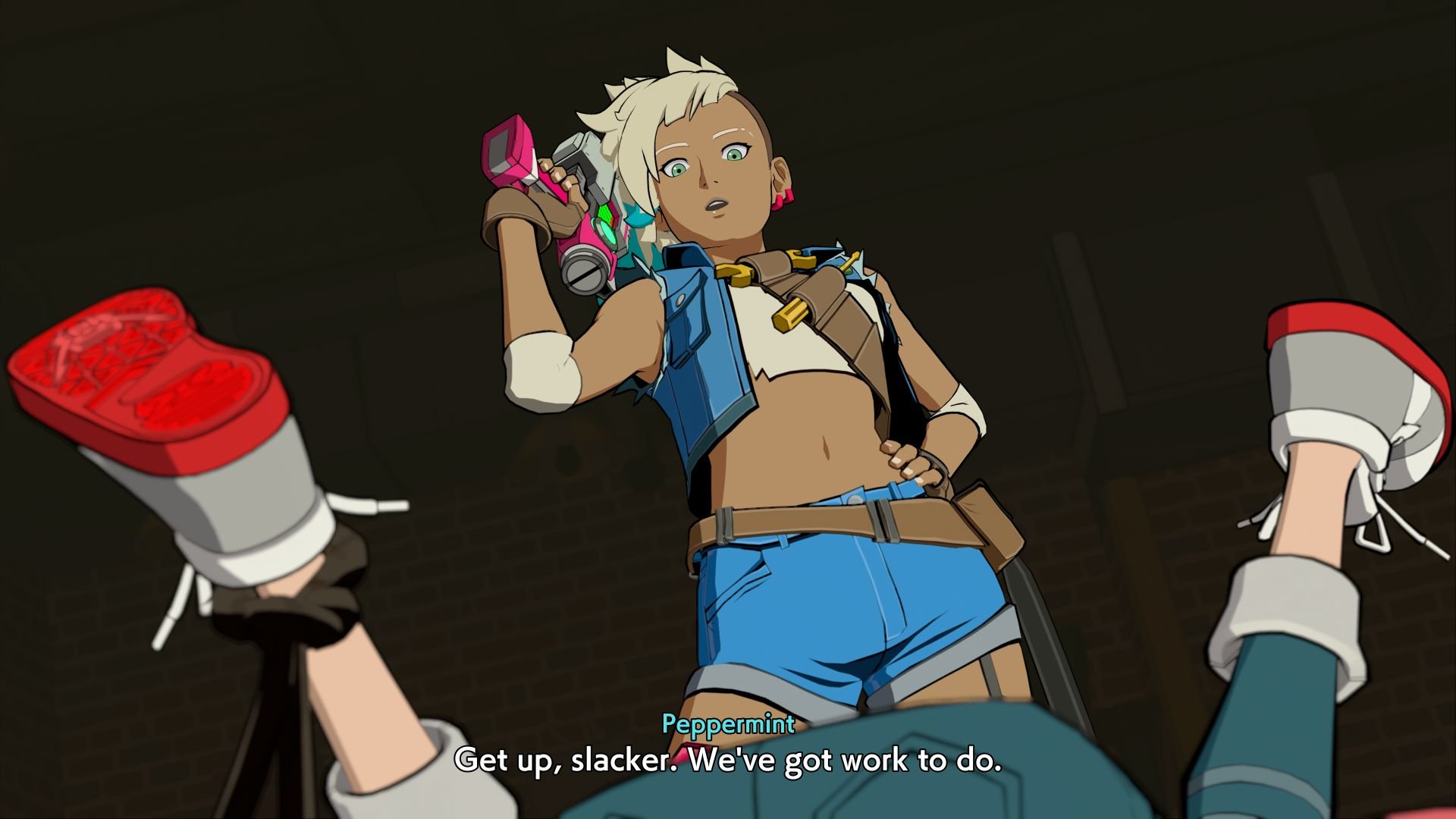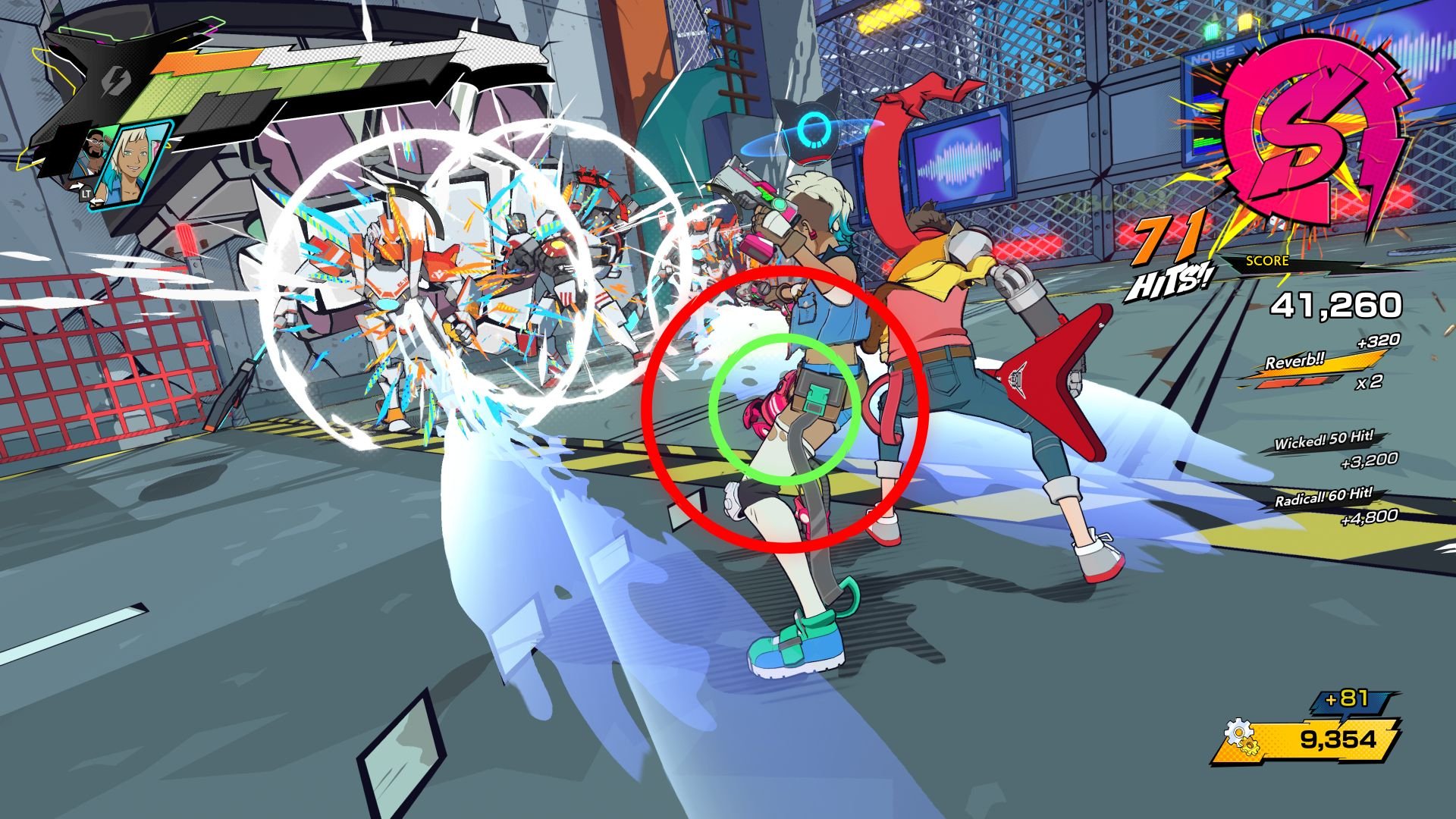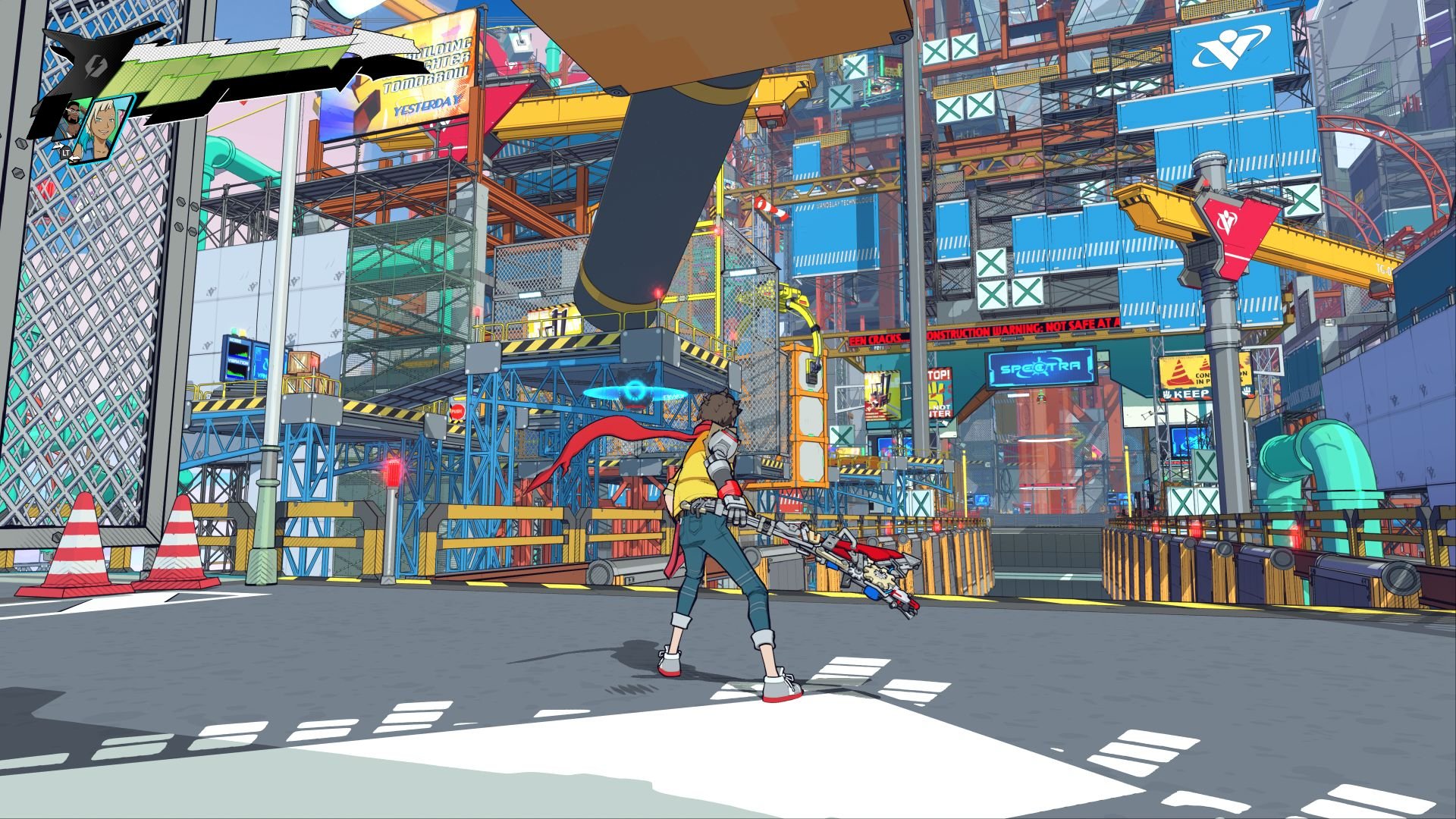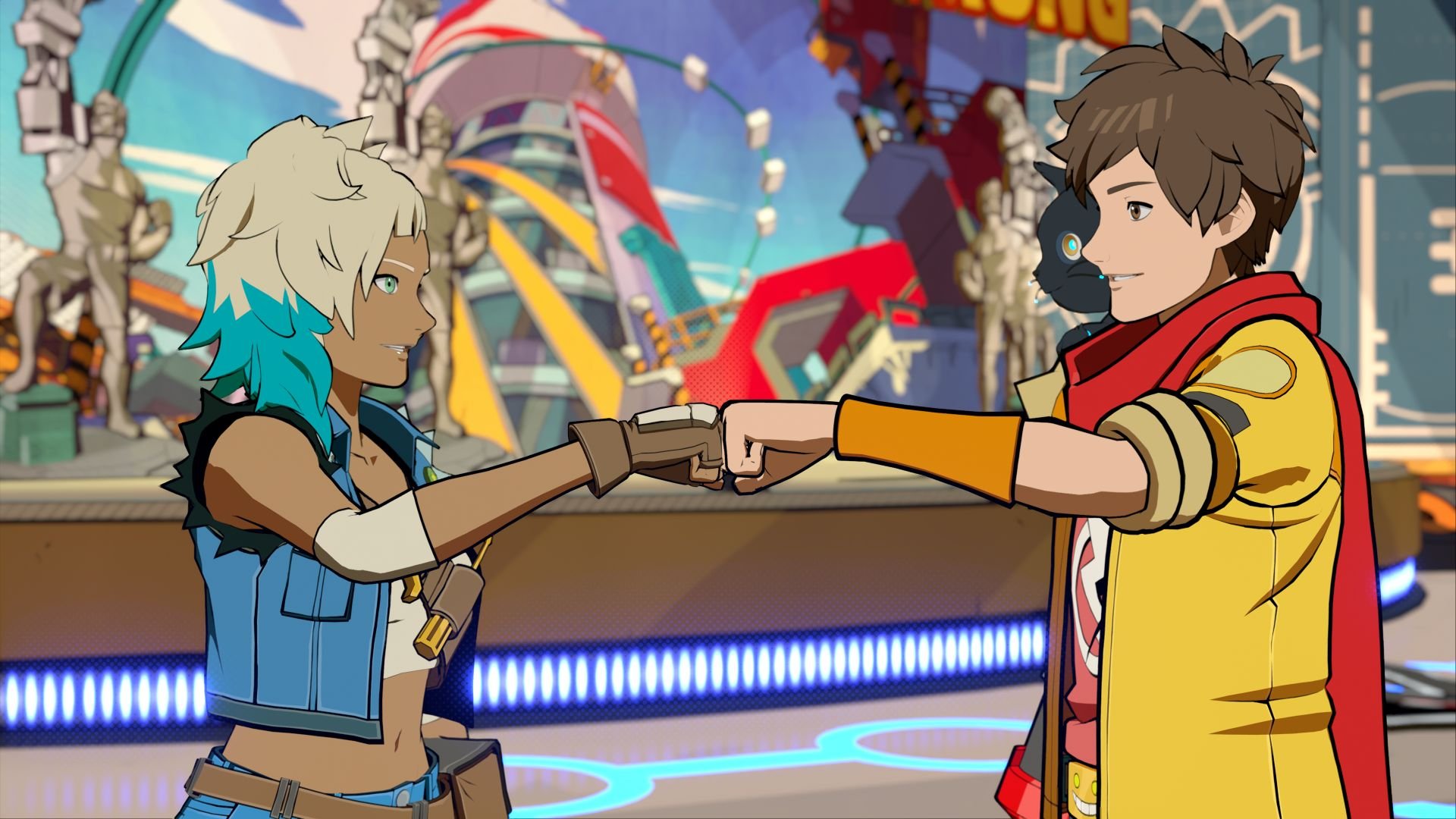Please don’t stop the music.
During the Xbox Developer_Direct, many were expecting brand-new looks at Redfall, Minecraft Legends, and Forza Motorsport. However, to everyone’s surprise, Tango Gameworks, developer of The Evil Within series, had one hell of an ace up their sleeve. It seems that over the past four years, a small team within the studio has been working on a brand new IP, one which would be a complete departure from their usual catalog and a title that might just redefine who Tango Gameworks even is.
Announced and released on the same day, Hi-Fi Rush is a high-energy character action game akin to something like Devil May Cry meets Sunset Overdrive, but in the visual style of what many would consider their dream setting for a new Jet Set Radio. Hi-Fi Rush is not only smartly written with an engaging cast of characters, but it might be one of the best-looking titles ever produced. Its cel-shaded world is colorful, vibrant, and immaculately detailed, offering up a playground for the senses that never lets up. Apart from one single annoyance towards the end of the game, my experience was damn near flawless. This is an absolute must-play.
Hi-Fi Rush is a bombastic action spectacle centered around Chai, a young goofball who is more or less a moron. After signing up for a promising career and a sweet robotic arm via the Vandelay Corporation, the process to give him this new metal appendage is partially disrupted by the presence of his music player mysteriously landing on his chest, creating a defect in his body as it is then grafted to him. This leaves him feeling the beat of the world around him, fusing his very motions with the flow of the rhythm nearby. It’s a clever way to make the beat-based gameplay work within the confines of the story in a way fitting to the tone Tango Gameworks is so effortlessly shooting for.
Once the Vandelay Corporation is made aware of this defect, they attempt to take him in, causing his new arm to react instinctively. Within seconds, a ranged claw pops out of his wrist and magnetizes all the loose metal scraps and bolts around him, forming a crude but efficient guitar axe. This newly assembled instrument of destruction is Chai’s main method of combat, with each of his attacks and special moves working alongside the beat that flows all around him. The world and movements all echo a visual pulse to you, as does the very UI that displays your health. Even Chai himself runs, jumps, and snaps his finger to the beat, making you very aware of the rhythm you need to match. While there is also an optional rhythm meter you do have access to, I never found I needed it with so many visual indicators already all around me.
As Chai attempts to make it out of the city, with Vandelay hot on his heels, he’ll encounter 808, a small robotic cat that is controlled by a young girl named Peppermint, a mechanic of sorts that has been investigating the Vandelay Corporation on her own and has uncovered a top-secret project that might spell doom should Vandelay have the means to execute on it. As the pair team up to take them down, they encounter like-minded individuals who join in their efforts to stop this diabolical corporation from seeing their plans come to fruition.
The full cast of characters is solid, with each bringing their own personality and charm to the group. While I’ll leave a particular addition to the team out to keep this review spoiler-free, I’ll touch upon those that are already part of the marketing surrounding the game. As mentioned, your first two companions are Peppermint and her robotic cat, 808. Peppermint can join Chai in battles sporting a dual set of pistols. If you recognize Peppermint’s voice, it’s likely due to the fact she is performed by Erica Lindbeck, who has a substantial résumé with the likes of Marvel’s Spider-Man, Fire Emblem: Engage, Soul Hackers 2, and a wealth of other appearances. While Chai is full of making jokes and going with the flow, largely improvising everything he does, Peppermint is constantly in his ear about trying to follow the plan and trying to keep him in check. Their banter is honestly fantastic and really develops into a believable friendship as the game progresses.
Joining Chai and Peppermint are Macaron and his robotic companion CNMN. Macaron is the former head of R&D for Vandelay and joins the cause to stop the company’s efforts once he learns of their plans. Macaron is largely a peaceful soul but is the team’s bruiser as he can shatter shields that Chai cannot penetrate. While CNMN, which is pronounced cinnamon, doesn’t join in during battle, this lovable robot uses a marker to change his expressions during conversations. This act is constantly funny and never once became stale. His role on the team may be small, but he leaves a big impression nonetheless.
Each of your companions can be used in battle, and offer their own unique element of bypassing obstacles that Chai on his own cannot. As mentioned, Macaron can shatter specialized shields that are used by a select few enemy types, as is the case with Peppermint as well, blasting away the bubble shields you're introduced to early on. The last character you’ll gain access to can use a twirling staff to put out fire-based attacks, snuffing them out. Each character can also be upgraded to pull off new moves or work alongside Chai for some tag-team special attacks. You can also upgrade each character via customized Chips that change how fast their cooldown is to various other perks. And, to top it off, once you beat the game, and lean into its endgame content, you can change the outfits of not just Chai, but these additional characters as well.
While Chai will share each and every battlefield with his friends, you can interact with them on a more personal basis between each mission at the hideout. While the hideout will vary between a few missions, you often retreat back to your standard base of operations to upgrade gear, check in on the bevy of challenges you have completed, and take in some training to better your skill. What is really great about this space is that should you quit in the middle of a boss fight and load the game back up to carry on, you’ll often start back at the base before heading back out, often treated to special dialogue that is only accessed during this exact scenario. And, to top it off, yes, you can pet and play with 808 while chilling on the couch.
Chai, Peppermint, Macaron, 808, CNMN, and the final companion are all interesting characters on their own, but the constant chatter and moments between them are what really sell this story. While there is a huge emphasis on the game’s humor that constantly delivers, the story has a surprising level of heart that I really adored. While there has been a lot of talk about “cringe” dialogue lately across all forms of media, especially surrounding Forspoken, I never once found anything here to be on that level, especially as the game is a living breathing cartoon and that sort of dialogue and delivery are part and parcel for the tone and charm of what Hi-Fi Rush is shooting for. Should you take this type of dialogue and place it in a ‘real world’ setting, then no, it doesn’t work. Here, it’s damn near magical.
This is one of the few games in recent memory where I was constantly laughing, rarely finding a joke that didn’t land. Regardless of it being some new expression that CNMN has drawn on his face in a split-second from the previous expression to the constant back and forth between Chai, his teammates, and his opponents. I was constantly impressed with how perfectly everything flowed and how natural the humor was delivered. Between some action moments, we get fully animated cutscenes that look great and honestly, if Microsoft ever decided to pursue a fully animated series, I’d be all in. Still, the characters, bosses, and genuinely good humor really help drive home the narrative, leaning into being both an action spectacle and a game that delivers solid genuine humor at a rapid pace.
Each of the locations you’ll visit ranges from wide open and incredibly detailed environments with a vast draw distance, to smaller and more platform-focused interiors. There is a decent selection of variety here given that this all takes place within the confines of a small city area within several Vandelay buildings. Levels often have moments where you’ll need to summon in your companions, as each has various ways to push through specific progression blockers. From smashing through a wall, shooting switches or nodes, to overpowering fans, each ability works towards the teamwork that Chai benefits from as he moves from room to room. Everything you do requires you to move to the beat, from timing your jumps to numerous platforms to using your team to push through each roadblock. This game is built around reacting to the pulse that lives all around you, and it’s everywhere at all times.
Adding to the arrangement of engaging characters are the villains themselves. The Vandelay bosses consist of Rekka, Korsica, Mimosa, Zanzo, Roquefort, and Kale Vandelay himself. Each of these bosses manages some aspect of Vandely, from marketing to budget, to security and R&D. Each boss is wonderfully performed and each fight is unique and varied. From pulling off parries in a fighting game-like scenario, on stage in front of thousands, to huge robots with attack patterns to memorize, I found each and every battle to absolutely sing and feel unique from one another.
Now, to challenge these bosses and all the robotic forces they send your way, you’ll have a deep and rewarding combat system to trounce a few nuts and bolts out of anything that gets in the way of Chai’s guitar axe. Combat is fun from the very first fight to well past its credits. Combat works off the rhythm that Chai feels all around him. You’ll see potted plants and roadside cones bouncing to the beat, as well as numerous other indicators all around you. Your moves and movement are all tied to this beat, and pulling off those actions on the beat is where the real magic of Hi-Fi Rush lives.
Chai’s main attack is by pressing X and his heavy attack is through Y. These operate on their own rhythm and knowing when to press them is how you’ll deal more damage to your enemy and is how you’ll pull off the ton of combo attacks you’ll unlock. You can largely ignore the beat if you simply want to hack and slash, but you’ll be rewarded with significantly more damage if you fight along the pulsating rhythm around you. Chai can dash, double-jump, and parry, and parry attacks are more associated with flashy strikes by some of the stronger enemies, who attack in a set beat you’ll need to mimic. And, should you pull it off, you can usually destroy them in a single strike as they explode behind Chai in glorious fashion.
Enemy variety from the smallest bot to the biggest titan is visually and functionally fun. Your robotic foes are expressive, chaotic, and often charming. From spider-like tanks to those that resemble felines and birds, there is a wild variety here that always remains great to encounter. One favorite of mine is the samurai brute, who has some pretty decent attacks, but it's his parry attack that makes him memorable. As he is about to issue out his party commands, the lights dim and a spotlight focuses on him while he proceeds to read poetry. Several other enemies have this type of humor and unique presence, making them feel truly engaging to encounter over and over again.
Aiding Chai in battle are his friends, summoned onto the field via a special teleporting trick through 808. You can press RT to bring them into battle and LT cycles through each of the three allies you have at your side. The overall combat is likened to that of Devil May Cry with over-the-top ground and ariel combat that have you earning a score as your dish out combo after combo. Having an S-grade combat encounter flowing during combat has a crowd chanting “Chai! Chai! Chai!” that really fuels you to continue to lay the smackdown. Every action you do in combat is rewarded with powerful-looking animations and effects to the audio scores of those fans chanting your name, it’s infectious.
As you earn scrap from battles and smashing boxes, you’ll spend it on new moves and special attacks. You’ll track down additional health slots to add to your health bar, and batteries to charge your special attacks. Chai has access to a ton of moves and so do your companions as you can change how they are summoned in to make them deal more damage and really become that much more beneficial to you. This game encourages teamwork and gives you all the tools needed to ensure success.
Each upgrade and new move feels worthwhile and the team-up attacks are just so much damn fun, especially those that work off a musical note bar at the bottom of the screen as you tap to the beat. And, as you unlock the ability to do so, you can equip two different special attacks at once, allowing you to swap between them to keep things fresh. Eventually, battles become an endless ballet of team-up attacks, parries, and pulling off insanely cool-looking combos. While it can look overwhelming at times, everything seamlessly flows together in a way where you'll be pulling all this off without a second thought.
As mentioned, combat feels fluid and just downright amazing. It’s sort of weird that this might be the most polished game I’ve played in years, given a lengthy period of time where every major release seemed to be infested with bugs and various technical hangups. Hi-Fi Rush just performs so solid and allows combat to be as chaotic as you want without any performance loss whatsoever. Pulling off special attacks or parries to each of the varied foes constantly felt fun, fluid, and entertaining, never once feeling repetitive or even stale in any regard. Not since Bayonetta 2 and DMC 5 have I been this impressed with this style of game and honestly, I just want more.
Now, wrapping up the game doesn’t end the fun as there is a decent chunk of endgame content to take on, from a challenging tower that offers up a wealth of rewards, to filling out a challenge wall that has its own share as well. You can also dive back into each level to find secret rooms that continue the hack-and-slash mayhem even further. The main adventure should run you around 10-12 hours with about 8-10 to see the rest of it through, which, for $30 USD, or accessed through all means of Xbox Game Pass, and you have what is without question, an amazing value.
I’ve stated it a few times already, but Hi-Fi Rush is stunning from top to bottom, creating some of the most detailed worlds I’ve ever seen with characters that I truly adore. Its cartoonish charm and cel-shaded look are top tier and each massive zone you enter into is polished to an insane degree, especially for being developed by such a small team within Tango Gameworks. Whether indoor or outdoor, Hi-Fi Rush is staggeringly beautiful, and the character models themselves are just great, offering up a ton of personality to go alongside the pitch-perfect voice acting. I honestly can’t say enough good things about this game as everything is just damn near flawless.
Now, I say damn near since the only issue I had whatsoever, is the game’s failure to indicate incorrect timing on a few of the game’s QTE’s. There is one section at the end where you perform a series of these actions, during a scene that should be rather touching and downright cool; however, I couldn’t tell why I was failing one particular part. Eventually, I realized that the long-press notes have to be immediately let go when the next note appears. Failing to do so will restart that whole segment. The game doesn’t convey this as a failed attempt until that segment was over, but left me without knowing why exactly I failed it to begin with. It took a scene that should have been quick and memorable, and sort of soured my enjoyment of that particular moment. It’s a small issue that didn’t ruin the game by any means but is something I did find frustrating.
Complimenting Hi-Fi Rush’s visuals and action is one hell of a soundtrack. From Nine Inch Nails to Prodigy, to The Black Keys and more, you have a damn impressive selection of songs that mix well with the personality that this game is overflowing with. “The Perfect Drug” and “Invaders must die” from NIN and Prodigy really work in the scenes they are attach to and The Black Key’s “Lonely Boy” fits this game’s charming action to a pixel of its life. Adding in a few new favorites in “Whirring” by The Joy Formidable, and “INAZAWA CHAINSAW” by Normal Girl, and I know exactly what I’m adding to my current playlist.
In regards to Accessibility, Hi-Fi Rush has a lot of solid additions. From simple measures in changing Font Size, and Colorblind settings, you also have Auto-Action mode that performs all the standard attacks and movements as long as you are pressing the attack button to the beat. This does limit what combo attacks will occur, but for those that want to enjoy the game and lack the skill needed to push through it, this mode can get a lot of people into this sort of genre. Adding on is a single-button rhythm mode that enables all rhythm games to default to a single-button press. The accessibility settings here are not mind-blowing, but it’s nice to see a few assist settings present for those that require it.
Hi-Fi Rush is a masterpiece, there’s really no other way to put it. My one annoyance aside, I had a blast cutting through droves of robots beaming with personality and style. The game is a sensational achievement in visuals and offers up one of the most breathtaking locales that constantly delivers stunning detail and personality. The visual guides of aiding you in finding the rhythm help its world feel alive and engaging, as does its wonderful cast of characters that I hope get to do this dance again. While shadow-dropping a title out of nowhere may not work for every game, its surprise release has nonetheless garnered it some well-deserved attention.
Developer - Tango Gameworks. Publisher - Bethesda Softworks / Microsoft. Released - January 25th, 2023. Available On - Xbox Series X/S, Windows. Rated - (T) Fantasy Violence, Language. Platform Reviewed - Xbox Series X. Review Access - Hi-Fi Rush was downloaded and played on Xbox Game Pass.





















Jeff is the original founder of Analog Stick Gaming. His favorite games include The Witcher III, the Mass Effect Trilogy, Hi-Fi Rush, Stellar Blade, Hellbade: Senua’s Sacrifice, and the Legend of Heroes series, especially Trails of Cold Steel III & IV.